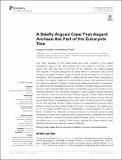A Briefly Argued Case That Asgard Archaea Are Part of the Eukaryote Tree
Author(s)
Fournier, Gregory P.; Poole, Anthony M.
Downloadfmicb-09-01896.pdf (1.125Mb)
PUBLISHER_CC
Publisher with Creative Commons License
Creative Commons Attribution
Terms of use
Metadata
Show full item recordAbstract
The recent discovery of the Lokiarchaeota and other members of the Asgard superphylum suggests that closer analysis of the cell biology and evolution of these groups may help shed light on the origin of the eukaryote cell. Asgard lineages often appear in molecular phylogenies as closely related to eukaryotes, and possess "Eukaryote Signature Proteins" coded by genes previously thought to be unique to eukaryotes. This phylogenetic affinity to eukaryotes has been widely interpreted as indicating that Asgard lineages are "eukaryote-like archaea," with eukaryotes evolving from within a paraphyletic Archaea. Guided by the established principles of systematics, we examine the potential implications of the monophyly of Asgard lineages and Eukarya. We show that a helpful parallel case is that of Synapsida, a group that includes modern mammals and their more "reptile-like" ancestors, united by shared derived characters that evolved in their common ancestor. While this group contains extinct members that share many similarities with modern reptiles and their extinct relatives, they are evolutionarily distinct from Sauropsida, the group which includes modern birds, reptiles, and all other amniotes. Similarly, Asgard lineages and eukaryotes are united by shared derived characters to the exclusion of all other groups. Consequently, the Asgard group is not only highly informative for our understanding of eukaryogenesis, but may be better understood as being early diverging members of a broader group including eukaryotes, for which we propose the name "Eukaryomorpha." Significantly, this means that the relationship between Eukarya and Asgard lineages cannot, on its own, resolve the debate over 2 vs. 3 Domains of life; instead, resolving this debate depends upon identifying the root of Archaea with respect to Bacteria.
Date issued
2018-08Department
Massachusetts Institute of Technology. Department of Earth, Atmospheric, and Planetary SciencesJournal
Frontiers in Microbiology
Publisher
Frontiers Research Foundation
Citation
Fournier, Gregory P., and Anthony M. Poole. “A Briefly Argued Case That Asgard Archaea Are Part of the Eukaryote Tree.” Frontiers in Microbiology, vol. 9, Aug. 2018. © 2018 Fournier and Poole.
Version: Final published version
ISSN
1664-302X